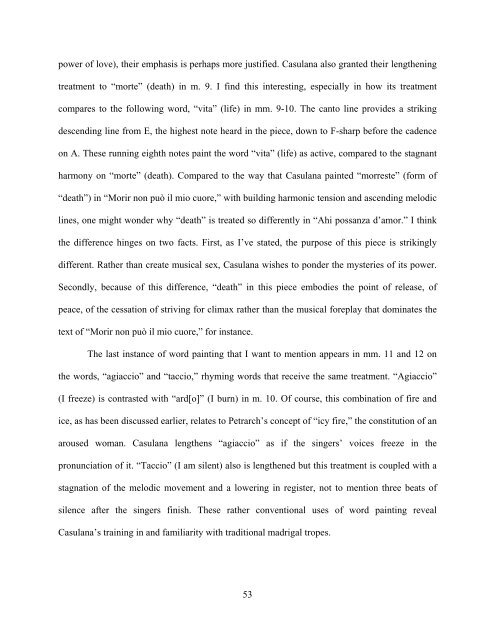Download - D-Scholarship@Pitt - University of Pittsburgh
Download - D-Scholarship@Pitt - University of Pittsburgh
Download - D-Scholarship@Pitt - University of Pittsburgh
Create successful ePaper yourself
Turn your PDF publications into a flip-book with our unique Google optimized e-Paper software.
power <strong>of</strong> love), their emphasis is perhaps more justified. Casulana also granted their lengthening<br />
treatment to “morte” (death) in m. 9. I find this interesting, especially in how its treatment<br />
compares to the following word, “vita” (life) in mm. 9-10. The canto line provides a striking<br />
descending line from E, the highest note heard in the piece, down to F-sharp before the cadence<br />
on A. These running eighth notes paint the word “vita” (life) as active, compared to the stagnant<br />
harmony on “morte” (death). Compared to the way that Casulana painted “morreste” (form <strong>of</strong><br />
“death”) in “Morir non può il mio cuore,” with building harmonic tension and ascending melodic<br />
lines, one might wonder why “death” is treated so differently in “Ahi possanza d’amor.” I think<br />
the difference hinges on two facts. First, as I’ve stated, the purpose <strong>of</strong> this piece is strikingly<br />
different. Rather than create musical sex, Casulana wishes to ponder the mysteries <strong>of</strong> its power.<br />
Secondly, because <strong>of</strong> this difference, “death” in this piece embodies the point <strong>of</strong> release, <strong>of</strong><br />
peace, <strong>of</strong> the cessation <strong>of</strong> striving for climax rather than the musical foreplay that dominates the<br />
text <strong>of</strong> “Morir non può il mio cuore,” for instance.<br />
The last instance <strong>of</strong> word painting that I want to mention appears in mm. 11 and 12 on<br />
the words, “agiaccio” and “taccio,” rhyming words that receive the same treatment. “Agiaccio”<br />
(I freeze) is contrasted with “ard[o]” (I burn) in m. 10. Of course, this combination <strong>of</strong> fire and<br />
ice, as has been discussed earlier, relates to Petrarch’s concept <strong>of</strong> “icy fire,” the constitution <strong>of</strong> an<br />
aroused woman. Casulana lengthens “agiaccio” as if the singers’ voices freeze in the<br />
pronunciation <strong>of</strong> it. “Taccio” (I am silent) also is lengthened but this treatment is coupled with a<br />
stagnation <strong>of</strong> the melodic movement and a lowering in register, not to mention three beats <strong>of</strong><br />
silence after the singers finish. These rather conventional uses <strong>of</strong> word painting reveal<br />
Casulana’s training in and familiarity with traditional madrigal tropes.<br />
53















